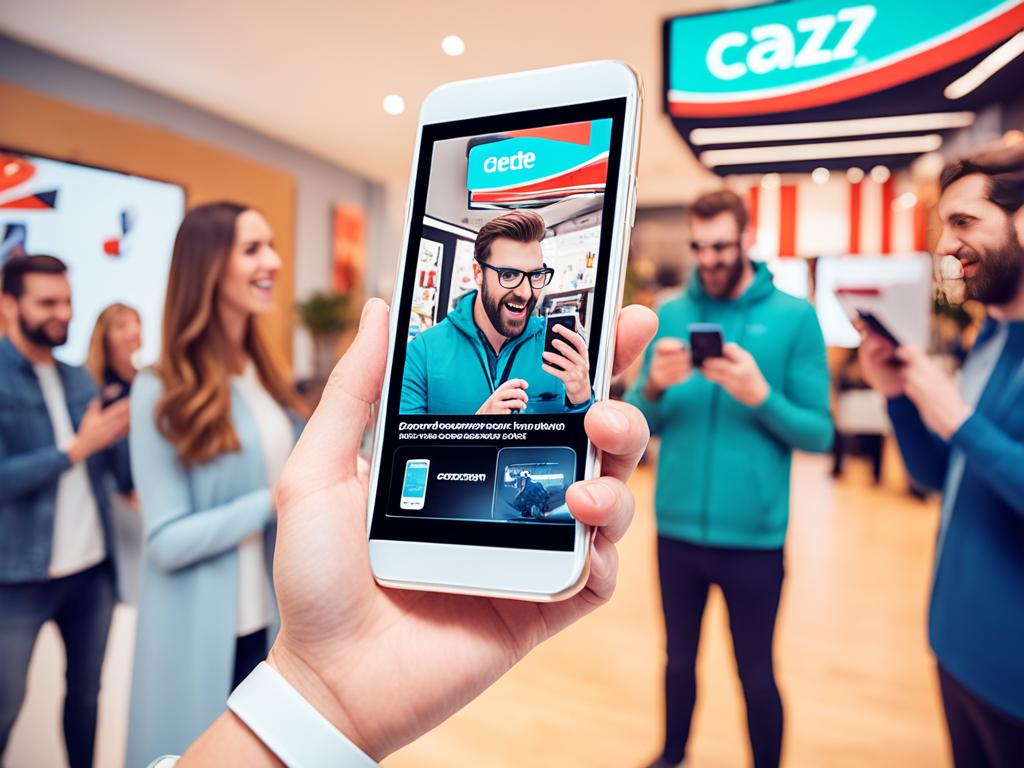Welcome to the exciting world of augmented reality (AR) in advertising and branding. In recent years, AR has emerged as a powerful tool for marketers to connect with consumers like never before. By overlaying digital content onto the real world, AR creates immersive experiences that captivate audiences and leave a lasting impression.
AR has revolutionized the way advertising and branding campaigns are executed, allowing brands to engage consumers in unique and interactive ways. With AR, you have the opportunity to bring your products and services to life, providing a memorable and personalized experience for your audience.
Imagine being able to try on virtual clothes before making a purchase or visualize how furniture would look in your living room without stepping foot in a store. AR enables these experiences and more, allowing consumers to engage with brands on a deeper level.
But what makes AR campaigns successful? It’s not just about the technology itself; it’s about crafting compelling narratives and delivering value to your audience. In the following sections, we will explore successful AR campaigns, the technical side of AR in marketing, consumer engagement through AR, and the future trends shaping AR advertising.
Whether you’re a small business or a global brand, integrating AR into your advertising and branding efforts can elevate your presence in the digital landscape. By embracing this cutting-edge technology, you can establish a deeper connection with your audience and differentiate yourself from your competitors.
So join us on this journey as we uncover the limitless possibilities of augmented reality in advertising and branding. Together, let’s unlock new dimensions of creativity and engagement that will propel your brand to new heights.
Key Takeaways:
- Augmented reality (AR) is transforming the advertising and branding industry, offering immersive and interactive experiences for consumers.
- Successful AR campaigns focus on crafting compelling narratives and delivering value to the audience.
- The technical side of AR involves developing and integrating AR applications, understanding hardware and software requirements, and overcoming implementation challenges.
- AR enhances consumer engagement through personalized experiences, brand storytelling, and emotional connections.
- The future of AR advertising includes advancements in wearable AR devices and spatial computing, shaping the advertising landscape in the coming years.
Successful AR Campaigns
Augmented reality (AR) has become a powerful tool in the world of advertising and branding. Through immersive experiences and interactive storytelling, AR campaigns have successfully captivated audiences and elevated brand visibility. In this section, we will explore some notable examples of successful AR campaigns and the strategies that contributed to their triumph.
Pokemon Go: Catching the Attention of Millions
When Pokemon Go was released in 2016, it took the world by storm. The mobile AR game allowed players to capture virtual Pokemon creatures in the real world using their smartphones. With its innovative use of AR technology and nostalgia-inducing characters, Pokemon Go attracted millions of players and became a global cultural phenomenon. The game’s success was a result of its ability to seamlessly blend the virtual and physical worlds, creating an engaging and addictive experience for users.
Snapchat: Transforming Self-Expression with AR Filters
Snapchat revolutionized the way people communicate by introducing AR filters that allow users to augment their photos and videos with various effects. From dog ears and flower crowns to face-swapping and dancing hotdogs, these filters became immensely popular among Snapchat users of all ages. By tapping into the desire for self-expression and playfulness, Snapchat successfully leveraged AR to enhance its user experience and strengthen its brand identity.
Coca-Cola: Bringing a Coca-Cola Santa to Life
Coca-Cola’s AR campaign during the holiday season of 2018 delighted customers by bringing the iconic Coca-Cola Santa Claus to life through AR-enabled packaging. By scanning specially designed cans and bottles using a mobile app, users could see Santa magically appear in front of them, interacting with their surroundings. This campaign not only created a memorable experience for consumers but also generated significant buzz and brand recognition for Coca-Cola.
IKEA: Visualizing Furniture in Your Home
With the IKEA Place app, customers can virtually place furniture items in their homes using AR technology. By simply pointing their smartphones at a space, users can see how IKEA products would look and fit in real-time. This innovative AR campaign addressed a common pain point for furniture shoppers – uncertainty about how items would look in their homes. By providing a solution that simplified the decision-making process, IKEA enhanced customer satisfaction and increased sales.
These examples demonstrate the immense potential of successful AR campaigns in the advertising and branding landscape. By leveraging immersive experiences, interactive storytelling, and real-time visualization, brands have successfully engaged audiences and strengthened their presence. Through the strategic use of AR, companies can create unforgettable experiences that resonate with consumers and drive brand loyalty.
The Technical Side of AR in Marketing
Implementing augmented reality (AR) in your marketing strategies requires a deep understanding of the technical aspects involved. This section will explore the technical side of AR in marketing, shedding light on the development, integration, and challenges faced by marketers in utilizing AR effectively to enhance advertising and branding efforts.
The Development of AR Applications
AR applications are developed using a combination of software and hardware technologies. Software developers use programming languages such as Unity and C# to create engaging and interactive AR experiences. These applications can range from simple image recognition overlays to complex 3D visualizations, depending on the desired marketing objectives.
Integration of AR Applications
Integrating AR applications into marketing campaigns requires careful planning and execution. Marketers need to consider the target audience, platform compatibility, and user experience when incorporating AR elements into their digital and offline channels. By seamlessly integrating AR with existing channels such as websites, social media platforms, and physical store displays, marketers can create cohesive and immersive brand experiences for their customers.
Hardware and Software Requirements
For users to engage with AR experiences, they need compatible hardware and software. This usually involves smartphones or tablets with AR-enabled capabilities, as well as specific AR applications installed on their devices. Marketers must consider these requirements when designing AR campaigns to ensure maximum reach and engagement.
Challenges in Utilizing AR Effectively
While AR offers exciting opportunities for marketers, there are also challenges that need to be addressed. Technical constraints, such as limited processing power and battery life of mobile devices, can impact the performance and usability of AR applications. Additionally, ensuring seamless integration across different platforms and devices can be a complex task. Marketers must stay updated on the latest advancements in AR technology to overcome these challenges and deliver impactful AR experiences.
AR in marketing requires a careful balance of creativity and technical expertise. By understanding the development process, integrating AR applications effectively, and addressing technical challenges, marketers can unlock the true potential of AR in enhancing advertising and branding efforts.
Continue reading to explore how AR enhances consumer engagement in advertising and branding in the next section.
Consumer Engagement Through AR
Augmented reality (AR) has revolutionized the way consumers engage with advertising and branding. By seamlessly integrating digital elements into the physical world, AR offers interactive and personalized experiences that captivate audiences and leave a lasting impression. In this section, we will explore the various ways in which AR enhances consumer engagement in advertising and branding.
Interactive Experiences
AR allows brands to create immersive and interactive experiences that capture consumers’ attention and keep them engaged. Through AR-powered apps or devices, users can interact with virtual objects, try on products virtually, or visualize how a product will look in their own space. These interactive experiences create a sense of excitement and empower consumers to actively participate in the brand’s story.
Personalization at Scale
AR enables brands to deliver personalized content and messaging to consumers based on their preferences and behavior. By leveraging AR technology, advertisers can tailor their campaigns to individual consumers, offering customized recommendations, promotions, or experiences. This level of personalization fosters a deeper connection between the consumer and the brand, leading to higher engagement and brand loyalty.
Promoting Brand Storytelling
AR provides a platform for brands to tell their stories in a more immersive and compelling way. Through AR experiences, brands can bring their narratives to life, capturing the audience’s attention and creating an emotional connection. Whether it’s a virtual tour of a brand’s history, an interactive storytelling campaign, or a behind-the-scenes glimpse into the making of a product, AR allows brands to engage consumers on a deeper level by delivering captivating narratives.
“AR enables brands to create immersive and interactive experiences that capture consumers’ attention and keep them engaged.”
Fostering Emotional Connections
AR has the power to evoke emotions and create memorable experiences for consumers. By combining the physical and digital worlds, AR triggers the imagination and creates a sense of wonder, excitement, or nostalgia. Whether it’s a branded AR game that brings joy and entertainment or an AR experience that conveys a brand’s values and purpose, fostering emotional connections is at the core of consumer engagement through AR.
Examples of Brands Using AR for Consumer Engagement
| Brand | AR Campaign |
|---|---|
| Nike | AR shoe try-on app allowing customers to see how shoes fit and look on their feet |
| IKEA | AR app for visualizing furniture in your home before making a purchase |
| Coca-Cola | AR campaign with interactive AR packaging that revealed hidden content when scanned |
These examples demonstrate how leading brands are leveraging AR to boost consumer engagement through innovative and captivating experiences. By embracing the potential of AR, brands can forge stronger connections with their target audience and differentiate themselves in a crowded marketplace.
In the next section, we will explore the future trends in AR advertising and how they will shape the industry’s landscape.
Future Trends in AR Advertising
As technology continues to evolve, the future of advertising and branding is set to witness a tremendous transformation with the integration of augmented reality (AR). The possibilities that AR brings to the table are captivating, pushing the boundaries of creativity and consumer engagement. Let’s explore some of the exciting future trends in AR advertising that are shaping the industry and revolutionizing the way businesses connect with their target audience.
1. Wearable AR Devices
One of the most anticipated trends in AR advertising is the adoption of wearable AR devices. These devices, such as smart glasses and headsets, offer a hands-free and immersive AR experience to consumers. Imagine walking into a retail store and seeing virtual product demonstrations or trying on virtual clothes using AR glasses. The potential for personalized and interactive advertising campaigns is immense, providing brands with a unique opportunity to engage customers in a whole new way.
2. Spatial Computing
Spatial computing is another future trend in AR advertising that holds immense potential. This technology enables the merging of virtual and physical worlds seamlessly, allowing users to interact with digital content in their real-life environments. Spatial computing opens up endless possibilities for advertisers to create immersive and contextually relevant experiences. From interactive product showcases to virtual pop-up stores, spatial computing revolutionizes the way brands can communicate with their target audience.
3. Enhanced Data Analytics
AR advertising not only offers new ways to engage consumers but also provides valuable data insights. In the future, we can expect enhanced data analytics capabilities that enable brands to gather detailed information about user interactions with AR content. This data can be used to refine advertising strategies, personalize user experiences, and optimize campaign performance. With advanced analytics tools, advertisers can gain a deeper understanding of consumer preferences and behavior, ultimately strengthening their advertising and branding efforts.
4. Social Media Integration
With the increasing prominence of social media in our lives, it’s no surprise that AR and social media integration are set to be a major trend in the future of advertising. Platforms like Instagram and Snapchat have already embraced AR filters and effects, allowing users to overlay digital content onto their real-world surroundings. This integration opens up new avenues for advertisers to reach a wider audience and create viral campaigns that resonate with social media users. Brands that leverage AR and social media integration will be able to tap into the immense reach and engagement potential of these platforms.
| Trends in AR Advertising | Description |
|---|---|
| Wearable AR Devices | Adoption of hands-free AR devices like smart glasses and headsets for immersive advertising experiences. |
| Spatial Computing | Merging virtual and physical worlds seamlessly to create immersive and contextually relevant AR experiences. |
| Enhanced Data Analytics | Utilizing advanced analytics tools to gather detailed insights on user interactions with AR content. |
| Social Media Integration | Integrating AR filters and effects into popular social media platforms to reach a wider audience. |
The future of AR advertising holds immense potential for brands to captivate and engage consumers in innovative ways. By embracing wearable AR devices, leveraging spatial computing, harnessing enhanced data analytics, and integrating AR with social media, advertisers can stay ahead of the curve and create impactful campaigns that leave a lasting impression.
Stay tuned for the concluding section of our article, where we summarize the key points discussed and touch upon ethical considerations in augmented reality marketing.
Conclusion
Throughout this article, we have explored the exciting world of augmented reality (AR) in advertising and branding. AR has revolutionized marketing efforts by providing immersive experiences that engage consumers in unique and interactive ways.
As we move forward, it is crucial to consider the ethical implications of augmented reality in marketing. Ensuring transparency, respecting user privacy, and maintaining trust are paramount to the success of AR campaigns. By taking these ethical considerations into account, brands can build stronger relationships with their customers and foster long-term loyalty.
Looking ahead, the future of AR advertising holds immense potential. Advancements in AR technology, such as wearable devices and spatial computing, will further enhance the effectiveness of marketing campaigns. By staying up to date with these future trends, brands can continue to captivate audiences and drive their businesses forward.
In conclusion, augmented reality has reimagined the advertising and branding landscape, allowing brands to connect with consumers on a deeper level. By embracing AR, considering ethical implications, and staying informed about future trends, brands can harness the power of this transformative technology and make their mark in the ever-evolving world of advertising and branding.







